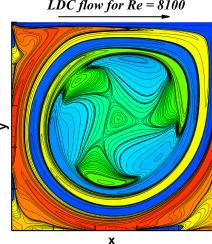方盖驱动腔内非定常流场的基准研究
IF 3
3区 工程技术
Q3 COMPUTER SCIENCE, INTERDISCIPLINARY APPLICATIONS
引用次数: 0
摘要
本工作提供了一个时间分辨基准数据集,用于模拟方形盖驱动腔(LDC)内的超临界非定常流动。为了解释计算的保真度和数值误差在触发不稳定性中的作用,用三个时间步长计算了流动。这项工作是通过使用误差动力学方程来证实的,该方程是利用模型对流扩散方程的全局谱分析(GSA)来模拟Navier-Stokes方程(NSE)中的物理过程。对于这一类特殊的流,发现误差是扩散主导的。对于超过雷诺数Re的方形最不饱和流场,目前还没有一致的结论。本研究旨在通过模拟Re在7900至8900范围内的LDC,详细讨论不稳定的开始,从而弥合这一差距。此外,最不发达国家通常观察到的第一个Hopf分岔是量化的,为开发数据驱动的机器学习替代昂贵的高保真仿真奠定了基础。本文章由计算机程序翻译,如有差异,请以英文原文为准。

Benchmark study of unsteady flow inside a square lid driven cavity
The present work provides a time-resolved benchmark dataset for simulating supercritical, unsteady flow inside a square lid-driven cavity (LDC). To explain the role of fidelity of the computations and that of the numerical error in triggering instabilities, the flow is computed with three time-steps. This effort is substantiated with the use of an error dynamics equation, developed to model the physical processes in the Navier–Stokes equation (NSE), using global spectral analysis (GSA) of a model convection–diffusion equation. The error is found to be diffusion-dominated for this particular class of flows. There exists lack of consensus regarding the critical value of Reynolds number () beyond which flow becomes unsteady for the square LDC. The study aims to bridge this gap by devoting a detailed discussion on the onset of unsteadiness by simulating LDC for in the range of 7900 to 8900. Furthermore, the first Hopf bifurcation that is typically observed for LDC is quantified, laying the foundation for development of data-driven machine learning alternatives to expensive high fidelity simulations.
求助全文
通过发布文献求助,成功后即可免费获取论文全文。
去求助
来源期刊

Computers & Fluids
物理-计算机:跨学科应用
CiteScore
5.30
自引率
7.10%
发文量
242
审稿时长
10.8 months
期刊介绍:
Computers & Fluids is multidisciplinary. The term ''fluid'' is interpreted in the broadest sense. Hydro- and aerodynamics, high-speed and physical gas dynamics, turbulence and flow stability, multiphase flow, rheology, tribology and fluid-structure interaction are all of interest, provided that computer technique plays a significant role in the associated studies or design methodology.
 求助内容:
求助内容: 应助结果提醒方式:
应助结果提醒方式:


